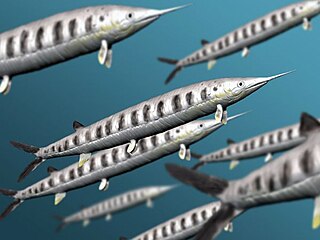Aspidorhynchus
Extinct genus of ray-finned fishes From Wikipedia, the free encyclopedia
Extinct genus of ray-finned fishes From Wikipedia, the free encyclopedia
Aspidorhynchus (from Greek: ᾰ̓σπίς aspís 'shield' and Greek: ῥύγχος rhúnkhos 'snout') is an extinct genus of predatory ray-finned fish from the Middle Jurassic to the earliest Cretaceous. Fossils have been found in Europe, Antarctica and the Caribbean.[1]
| Aspidorhynchus Temporal range: | |
|---|---|
 | |
| Fossil of Aspidorhynchus sanzenbacheri | |
| Scientific classification | |
| Domain: | Eukaryota |
| Kingdom: | Animalia |
| Phylum: | Chordata |
| Class: | Actinopterygii |
| Order: | †Aspidorhynchiformes |
| Family: | †Aspidorhynchidae |
| Genus: | †Aspidorhynchus Agassiz, 1833 |
| Type species | |
| †Esox acutirostris Blainville, 1818 | |
| Species | |
|
See text | |
Aspidorhynchus was a slender, fast-swimming fish, some species reach 85 centimetres (2.79 ft) long,[1] with tooth-lined, elongated jaws. It also had heavy scales and a symmetrical tail. The upper jaw was longer than the lower jaw, ending in a toothless spike. Although it would have looked superficially similar to the present day gars, it was not related to them, belonging to the Aspidorhynchiformes, an extinct group of fish noted for their elongated rostrums. Aspidorhynchiformes are generally considered early relatives of teleosts.[2]

Aspidorhynchus contains the following species:[3]
A. antarcticus is known from Jurassic remains reworked into the Albian Whisky Bay Formation, and was the oldest neopterygian fossil discovered in Antarctica at the time.[5] However, some studies have instead classified it in Vinctifer, which was later also identified from the same formation.[6] Other species previously classified in Aspidorhynchus, such as A. comptoni, have also since been moved to Vinctifer, whereas others have been moved to Belonostomus.
A potential species, A. montissancti Gorjanović-Kramberger, 1895 is known from the Cenomanian of Slovenia.[3]


Several limestone slabs have been discovered in which fossils of Rhamphorhynchus are found in close association with Aspidorhynchus. In one of these specimens, the jaws of an Aspidorhynchus pass through the wings of the Rhamphorhynchus specimen. The Rhamphorhynchus also has the remains of a small fish, possibly Leptolepides, in its throat. This slab, cataloged as WDC CSG 255, may represent two levels of predation; one by Rhamphorhynchus and one by Aspidorhynchus. In a 2012 description of WDC CSG 255, researchers proposed that the Rhamphorhynchus individual had just caught a Leptolepides while it was flying low over a body of water. As the Leptolepides was travelling down its pharynx, a large Aspidorhynchus would have attacked from below the water, puncturing the left wing membrane of the Rhamphorhynchus with its sharp rostrum. The teeth in its snout were ensnared in the fibrous tissue of the wing membrane, and as the fish thrashed to release itself the left wing of the Rhamphorhynchus was pulled backward into the distorted position seen in the fossil. The encounter resulted in the death of both individuals, most likely because the two animals sank into an anoxic layer in the water body, depriving the fish of oxygen. The two may have been preserved together as the weight of the head of the Aspidorhynchus held down the much lighter body of the Rhamphorhynchus.[7]
Seamless Wikipedia browsing. On steroids.
Every time you click a link to Wikipedia, Wiktionary or Wikiquote in your browser's search results, it will show the modern Wikiwand interface.
Wikiwand extension is a five stars, simple, with minimum permission required to keep your browsing private, safe and transparent.